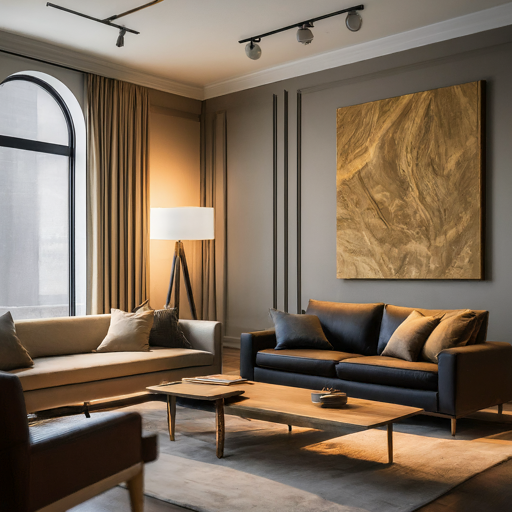Creating a rich, inviting living room is all about mastering the art of layering textures. Textures add depth, interest, and a tactile quality that can transform a flat, lifeless space into a cozy, dynamic haven. This guide will walk you through the steps of layering textures to achieve a luxurious living room design, complete with image suggestions to inspire your decorating journey.
1. Start with a Neutral Base
A neutral base is essential for layering textures effectively. It provides a versatile backdrop that allows various textures to stand out without overwhelming the space. Choose neutral colors like whites, grays, beiges, or soft pastels for your walls, large furniture pieces, and floor coverings.

2. Mix Different Fabrics
Incorporate a variety of fabrics to add warmth and richness to your living room. Think beyond just your sofa and curtains—consider cushions, throws, and upholstery as opportunities to introduce texture. Some fabric options include:
- Velvet: Luxurious and soft, perfect for cushions or an accent chair.
- Linen: Light and airy, ideal for curtains or casual slipcovers.
- Wool: Warm and cozy, great for throws or area rugs.
- Cotton: Versatile and easy to care for, suitable for almost any textile.

3. Add Layers with Rugs
Rugs are a fantastic way to introduce texture to your living room. Layering rugs can create a plush, inviting feel underfoot and visually anchor different areas within the space. Consider mixing:
- Natural Fiber Rugs: Jute, sisal, or seagrass rugs add an organic, earthy texture.
- Wool Rugs: Soft and warm, they bring a touch of luxury.
- Patterned Rugs: Introduce visual interest and can tie together different textures.

4. Incorporate Textured Wall Decor
Wall decor is another excellent way to layer textures. Think beyond traditional framed art and explore options like:
- Tapestries: Add a bohemian vibe and soft texture to your walls.
- Macrame: Perfect for a relaxed, casual feel with a handcrafted touch.
- Textured Wall Panels: Wooden, cork, or fabric panels can create a striking focal point.
5. Use Textured Furniture
Furniture with texture can make a significant impact on your living room’s design. Look for pieces that incorporate materials like:
- Wicker or Rattan: Ideal for chairs, coffee tables, or storage baskets.
- Distressed Wood: Adds character and a rustic charm.
- Tufted Upholstery: Brings a classic, sophisticated texture.

6. Accessorize with Layers
Accessories are the final touch in layering textures. Incorporate a variety of elements such as:
- Pillows: Mix and match different fabrics, patterns, and sizes.
- Throws: Drape them over sofas or chairs for added warmth and texture.
- Decorative Objects: Consider ceramic, glass, metal, and wood pieces to create visual and tactile diversity.

7. Embrace Natural Elements
Natural elements add an organic texture that can balance out more refined materials. Incorporate:
- Plants: Foliage adds both visual and tactile texture.
- Stone: Use in features like fireplaces, coffee table tops, or decorative objects.
- Wood: Natural wood elements, whether in furniture or decor, bring warmth and texture.

8. Experiment with Patterns
Patterns can add another layer of texture, especially when used in conjunction with tactile materials. Consider:
- Geometric Patterns: On cushions, rugs, or wallpaper for a modern touch.
- Floral Patterns: For a softer, more traditional feel.
- Abstract Patterns: To add a contemporary edge.
9. Layer Lighting
Lighting can also contribute to the textural feel of your living room. Use a mix of:
- Ambient Lighting: Soft, diffused light from ceiling fixtures or wall sconces.
- Task Lighting: Focused light from floor lamps or table lamps for reading or work areas.
- Accent Lighting: Highlight textured walls or decor with spotlights or LED strips.

10. Create a Focal Point
Finally, create a focal point that draws the eye and anchors the room’s design. This could be:
- A Textured Accent Wall: Painted in a rich color or covered with textured wallpaper.
- A Statement Piece of Furniture: Like a tufted sofa or a unique wooden coffee table.
- An Eye-Catching Art Piece: A large, textured artwork or a collection of smaller pieces.

Layering textures is a powerful design technique that can transform your living room into a rich, inviting space. By starting with a neutral base and thoughtfully adding a variety of fabrics, rugs, wall decor, furniture, accessories, and natural elements, you can create a room that feels both luxurious and cozy. Let these tips and image suggestions guide you in curating a living room that truly feels like a textile treasure trove.
By incorporating these elements, you can create a layered, textured living room that exudes warmth, comfort, and style.

Leave a Reply